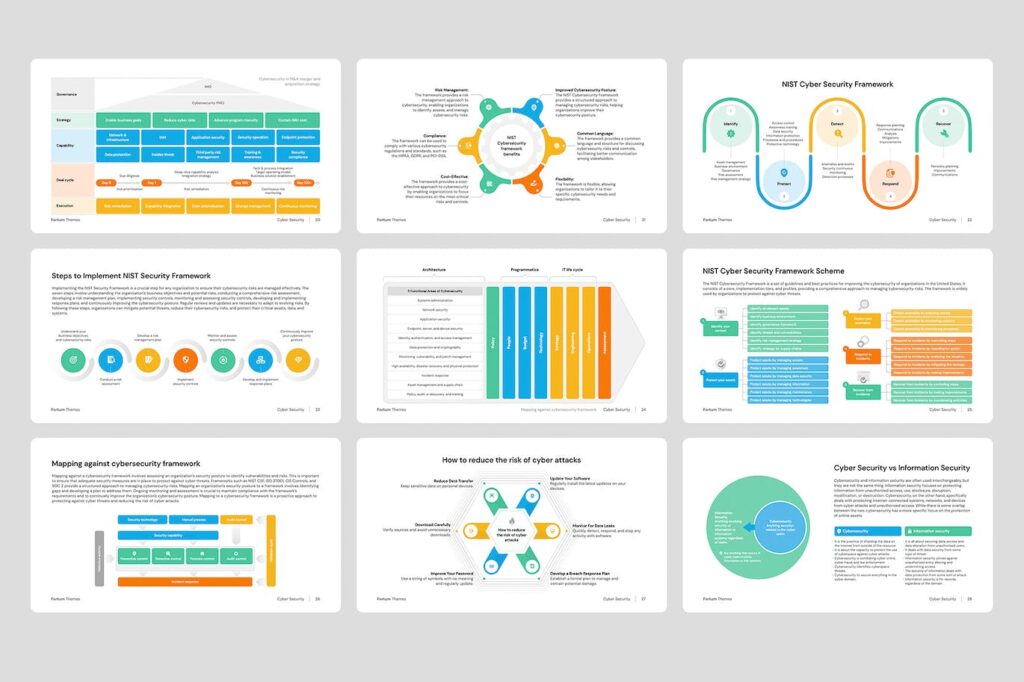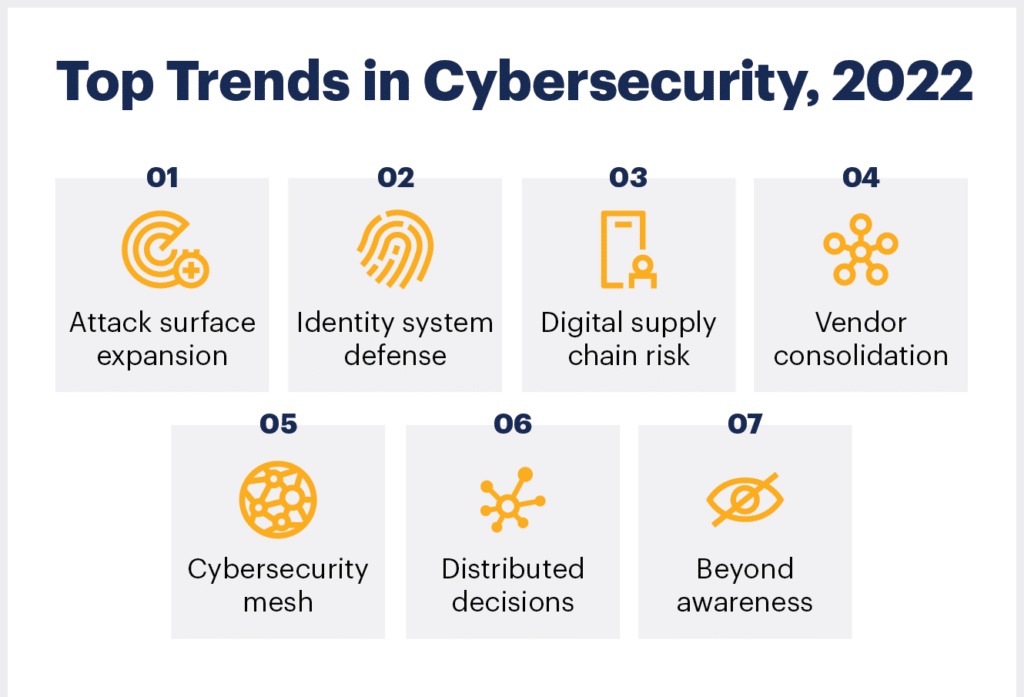
Generating Cybersecurity project ideas is vital for a rich cybersecurity portfolio, which will showcase expertise by highlighting your abilities. Use our tips and strategies to come up with relevant and exciting ideas.
To build innovative Cybersecurity project ideas, consider these:
- Identify your interests
- Draw your Project’s Outline
- Get inspired by existing cybersecurity projects on the internet.
- Research current trends and Open-source tools like Metasploitable, Nmap…
- Analyze case studies
- Structure your Outline
First, it’s crucial to understand your strengths and interests within the cybersecurity landscape.
Identify your areas of expertise to showcase your skills effectively in projects. For example, are you skilled in ethical hacking, data analysis, or cryptography?
Consider your career goals and interests when identifying your strengths to focus on projects aligned with your desired path.
Research recent cybersecurity breaches, trends, and challenges to brainstorm solutions for your portfolio. Address real-world problems to increase your value to potential employers.
Why Is It Important to Work on Side Projects?
To Apply the Skills You’ve Learned
Side projects in cybersecurity are a great way to use your technical skills in a practical setting. You’ll gain hands-on experience in threat detection, mitigation, and vulnerability assessment while improving your programming and networking abilities.
Building a Portfolio of Work
Your portfolio will display your skills and achievements. It showcases your dedication to the field, emphasizes your experience, and offers concrete proof of your technical capabilities..
Consider the following inot your Portfolio:
- Project descriptions: Briefly explain each project and its purpose.
- Technical skills showcased: List the specific programming languages, tools, and methodologies you used.
- Results and impact: Highlight the outcomes and impact of your efforts on the project.
- Visual aids: Include screenshots, diagrams, or links to live demos when applicable for a more engaging presentation.
Remember to keep your portfolio focused on projects that best represent your current capabilities and professional interests.
Don’t hesitate to update it regularly with new work as you continue to learn, grow, and evolve in cybersecurity.
How Do I Make a Creative Portfolio
Showcase proficiency in network monitoring, firewall configuration, encryption, and penetration testing to builds a reliable cybersecurity portfolio and highlights creativity and skills in the industry.
You can demonstrate your programming abilities as well by including projects using programming languages like Python, SQL, and PHP.
What Should a Creative Portfolio Look Like?
Use a clear layout with headings and bullet points for easy understanding.
Use tables and charts to simplify information for potential employers. Ensure user-friendly navigation.
What Should Be Included in a Cybersecurity Portfolio

A cybersecurity portfolio should include the following:
- Personal Information: Name, contact details, and a brief professional summary.
- Education: List your relevant educational background and certifications.
- Work Experience: Highlight your professional experience in the cybersecurity field.
- Projects: Showcase various projects demonstrating your skills in different areas of cybersecurity, such as firewalls, encryption, and penetration testing.
- Programming Languages: Mention the programming languages, like Python, SQL, or PHP, that you are proficient in.
- Tools and Technologies: Detail the cybersecurity tools and technologies you have experience with, such as network monitoring or cryptography software.

What Kind of Projects Should You Include in Your Portfolio
Incorporate diverse cybersecurity projects that reflect your expertise, such as:
- Network monitoring: Develop a Python-based network monitoring tool.
- Firewall configuration: Document how you set up and configured a firewall for an organization.
- Encryption: Create file encryption and decryption tool using cryptography techniques.
- Penetration testing: Exhibit a step-by-step tutorial on conducting a penetration test for a web application.
- Keylogger: Build a keylogger in Python to demonstrate your understanding of how attackers can collect user information.

Including a wide range of projects will showcase your versatility and adaptability in cybersecurity.
Here are some of the pros of building Personal Projects:
- A Tremendous Benefit for Your Job Application
A well-made cybersecurity portfolio can enhance your chances of landing a job by showcasing your skills and experience to potential employers.
- Gaining Credibility: Show off Your Skills
Boost your credibility and expertise in cybersecurity by sharing tutorials, blog posts, or webinars on online platforms like YouTube. It can strengthen your cybersecurity portfolio and showcase your skills.
How to Brainstorm New Cybersecurity Project Ideas

Identify Your Interest: Cybersecurity Domains
Choose a cybersecurity domain that interests you, like vulnerability management, attack analysis, prevention, or breach response.
Identifying the specific areas that interest and motivate you can help you develop project ideas that match your skills and passions.
Look for Existing Project Ideas Online

Search for existing project ideas on online platforms like Github, Youtube, and Hackthebox.
These platforms offer cybersecurity resources like repositories, tutorials, and challenges.
Explore these resources to gather inspiration for your projects and understand what others have already accomplished in your field of interest.
Research Current Cybersecurity Trends

Stay ahead of new and emerging cybersecurity trends to identify new and emergent challenges. You can discover new attack vectors, vulnerabilities, or protection methods shaping cybersecurity by researching the latest news.
We recommend monitoring response and recovery procedures for recent security breaches in both the public and private sectors.
Research Open-source Tools
Investigate the various open-source tools available for cybersecurity. Many tools, such as those for vulnerability management or antivirus software, can help you explore different aspects of cybersecurity.
Open-source communities share resources and ideas, making it easier to gather inspiration for projects.
Knowing programming languages such as Python and C is crucial for effectively using cybersecurity tools, as they play a significant role in this field.
Analyze Case Studies
It is helpful to examine case studies of past incidents to understand real-world cybersecurity challenges.

In addition, you can gain valuable insights by analyzing the attack vectors, security vulnerabilities, and targeted intellectual property.
By evaluating how organizations have responded and recovered, you can identify gaps in current strategies and generate project ideas that address these issues.
Structure Your Outline: By Adding Your Own Spin on It
After gathering inspiration and information from various sources, it’s essential to structure your project outline to highlight your unique perspective.
And consider putting your spin on existing ideas or trying out new trends and tools that have yet to gain widespread popularity.

Creating an original and innovative project will make you stand out when building your cybersecurity portfolio.
Following these steps, you can successfully brainstorm new cybersecurity project ideas and create a strong foundation for your cybersecurity portfolio.
Conclusion
To wrap it up, developing innovative cybersecurity project ideas starts with identifying your areas of interest and strengths. Then do your research. Brainstorm ideas, and write down every idea that comes to mind, even the most unrealistic ones. Refine your ideas, and create a clear plan. Test your ideas and refine them.
Then once your project is complete, please showcase it online. Put yourself out there. We live in the content era. A time when no one can afford not to share content.
Remember to think outside of the box and stay creative. Who knows? your unique project could be the next big thing in cybersecurity or the Tech industry. Stay cultivated.
